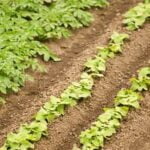Are you looking to start a vegetable garden in zone 6a? Known for its cool winters and warm summers, zone 6a provides an ideal environment for growing a wide variety of vegetables. In this article, we will explore the characteristics that make zone 6a perfect for vegetable gardening, as well as provide tips and recommendations for successful cultivation.
With its moderate climate and defined seasons, zone 6a offers gardeners the opportunity to grow a diverse range of vegetables throughout the year. From tomatoes to peppers, you’ll find that many popular vegetable varieties thrive in this zone. By understanding the unique attributes of zone 6a and tailoring your gardening practices to suit its conditions, you can create a productive and thriving vegetable garden.
In order to maximize the potential of your vegetable garden in zone 6a, it’s essential to prepare the soil properly. By taking the time to enrich and cultivate your soil, you can provide your plants with the essential nutrients they need to flourish.
We will delve into soil preparation techniques that are specific to zone 6a, helping you lay the groundwork for a successful harvest. Additionally, we will provide guidance on extending the growing season in this climate, as well as managing pests and diseases that may affect your vegetable crops.
Best Vegetable Varieties for Zone 6A
When it comes to vegetable gardening in Zone 6A, choosing the right varieties for the climate and growing conditions is crucial for a successful harvest. Here are some of the best vegetable varieties that thrive in Zone 6A and will yield a bountiful harvest:
1. Tomatoes: Consider planting varieties such as Early Girl, Brandywine, Rutgers, or Roma tomatoes. These varieties are known for their ability to withstand the cooler temperatures in Zone 6A and produce delicious fruits.
2. Peppers: For pepper plants that thrive in Zone 6A, look for varieties like Sweet Banana peppers, Jalapeno peppers, Bell peppers, or Poblano peppers. These varieties are well-suited for the region’s climate and will yield vibrant and flavorful peppers.
3. Lettuce: Growing lettuce in Zone 6A is a great choice, as it thrives in cooler temperatures. Varieties like Buttercrunch, Romaine, and Red Sails lettuce are excellent options for your vegetable garden.
4. Carrots: When it comes to root vegetables, consider planting Nantes carrots or Danvers carrots in your Zone 6A vegetable garden. These varieties are known for their sweet flavor and ability to thrive in cooler climates.
By choosing these vegetable varieties specifically suited to Zone 6A, you can ensure a successful harvest while maximizing your garden’s potential.
Additionally, implementing crop rotation techniques can help ward off pests and diseases common to the region while also improving soil quality over time. With proper care and attention to detail when selecting plant varieties for your Zone 6A vegetable garden, you can look forward to a rewarding growing season with a plentiful harvest of fresh produce.
Soil Preparation for Successful Vegetable Gardening in Zone 6A
When it comes to successful vegetable gardening in Zone 6A, proper soil preparation is key. The following are some essential tips for preparing the soil in this specific zone:
1. Test and Amend the Soil: Before planting, it’s important to test the soil pH and nutrient levels. Most vegetables thrive in slightly acidic soil with a pH level between 6.0 and 6.8. If necessary, adjust the pH level by adding lime to raise it or sulfur to lower it. Additionally, amend the soil with compost or organic matter to improve its structure and fertility.
2. Raised Beds vs. In-Ground Planting: In Zone 6A, raised beds can be particularly beneficial for vegetable gardening as they improve drainage and allow for better control over the soil composition. However, if you prefer in-ground planting, ensure that the soil is well-draining by adding organic matter and loosening compacted areas.
3. Mulching: Mulching is essential for retaining moisture, suppressing weeds, and regulating soil temperature in Zone 6A vegetable gardens. Organic mulches such as straw, grass clippings, or shredded leaves can be applied around plants once they are established.
By following these soil preparation tips, vegetable gardeners in Zone 6A can create an optimal growing environment for their crops while promoting healthy plant growth and high yields.
Additionally, consider incorporating techniques such as crop rotation and cover cropping to further improve soil health and fertility in your vegetable garden.
Tips for Extending the Growing Season in Zone 6A
Extending the growing season in Zone 6A vegetable gardening is essential to maximize yield and enjoy fresh produce for a longer period. This section will discuss various tips and techniques that can be used to extend the growing season in this particular zone.
Using Row Covers
Row covers are an effective way to protect plants from frost and extend the growing season. By covering the vegetable garden with row covers, gardeners can provide a few degrees of protection from cold temperatures, allowing plants to thrive for a longer period. Floating row covers made of lightweight fabric are a popular choice as they allow sunlight, air, and moisture to reach the plants while offering protection from frost.
Utilizing Cold Frames or High Tunnels
Cold frames and high tunnels are another great option for extending the growing season in Zone 6A. These structures create a microclimate that is warmer than the surrounding environment, providing a protective space for plants. Cold frames are typically lower to the ground and can be made using materials such as wood and plastic sheeting, while high tunnels are larger and taller structures made of metal or PVC piping covered with plastic.
Planting Cold-Tolerant Vegetables
Choosing cold-tolerant vegetable varieties is also crucial for extending the growing season in Zone 6A. Vegetables such as kale, spinach, carrots, and radishes can withstand cooler temperatures and even improve in flavor after being exposed to light frosts. By selecting these varieties, gardeners can continue harvesting fresh produce well into the fall months.
By implementing these tips for extending the growing season in Zone 6A vegetable gardening, individuals can enjoy an extended harvest period and make the most of their garden throughout the year.
Pest and Disease Management in Zone 6A Vegetable Gardens
Common Pests
In Zone 6A, vegetable gardens may be susceptible to a variety of pests such as aphids, cabbage worms, cutworms, and squash bugs. These pests can wreak havoc on your carefully cultivated crops if left unchecked. It is important for gardeners in this zone to familiarize themselves with the common pests in the area and to monitor their plants regularly for any signs of infestation.
Natural Pest Control Methods
One effective approach to managing pests in Zone 6A vegetable gardens is through natural pest control methods. This can include introducing beneficial insects like ladybugs and praying mantises that feed on harmful pests. Additionally, planting companion plants such as marigolds and nasturtiums can help deter certain pests. For more stubborn infestations, organic insecticidal soaps or neem oil can be used as a less harmful alternative to chemical pesticides.
Disease Prevention
Diseases such as blight and powdery mildew can also pose a threat to vegetable gardens in Zone 6A. To prevent the spread of disease, it is important to practice good garden hygiene by removing any infected plant material and providing proper air circulation between plants. Choosing disease-resistant varieties of vegetables can also help minimize the risk of encountering these issues.
Finally, maintaining healthy soil with the appropriate pH levels can bolster the plants’ natural defenses against disease. By staying vigilant and employing these preventive measures, gardeners can keep their Zone 6A vegetable gardens thriving throughout the growing season.
Companion Planting
Companion planting is a gardening technique that involves planting different types of plants in close proximity to one another to maximize space and yield. In Zone 6A, where space may be limited and the growing season is relatively short, companion planting can be especially beneficial for vegetable gardens. By understanding which plants work well together, gardeners in Zone 6A can make the most of their garden space and improve overall plant health and yield.
One popular example of companion planting in Zone 6A vegetable gardens is the Three Sisters method, which involves planting corn, beans, and squash together. The corn provides support for the beans to climb, while the beans add nitrogen to the soil, benefiting all three crops. The squash serves as ground cover, helping to retain moisture and suppress weeds. This interplanting not only maximizes space but also creates a balanced ecosystem that promotes healthy growth.
In addition to the Three Sisters method, there are numerous other companion planting combinations that work well in Zone 6A vegetable gardens. For example, planting aromatic herbs like basil or parsley near tomatoes can help deter pests and improve tomato flavor.
Interplanting lettuce with taller crops like peppers or eggplant can provide shade and protection from hot sun, extending the growing season for these heat-sensitive vegetables. By incorporating diverse plant combinations into their gardens, Zone 6A vegetable growers can reap the benefits of healthier plants and higher yields.
The Importance of Proper Watering in Zone 6A Vegetable Gardening
When it comes to vegetable gardening in Zone 6A, proper watering is essential for the success of your garden. With average annual rainfall and specific weather patterns in this zone, gardeners need to understand the importance of providing adequate moisture to their vegetable plants.
One key aspect of proper watering in Zone 6A vegetable gardening is understanding the water needs of different types of vegetables. For example, leafy greens such as lettuce and spinach require more frequent watering compared to root vegetables like carrots and beets. Additionally, certain fruiting vegetables such as tomatoes and peppers may need consistent moisture to prevent issues like blossom end rot.
Another crucial factor to consider is the timing of watering. In Zone 6A, where summers can bring periods of hot and dry weather, it’s important to water early in the morning or later in the evening to minimize evaporation and ensure that plants can take up the water effectively. Using techniques such as drip irrigation or soaker hoses can also help deliver water directly to the root zones of plants, reducing waste and promoting healthy growth.
Proper soil moisture levels are essential for avoiding common issues such as stunted growth, poor fruit development, and susceptibility to pests and diseases. By paying attention to proper watering practices, gardeners in Zone 6A can maximize the yield and quality of their vegetable crops.
| Watering Tips | Key Takeaways |
|---|---|
| Understand water needs of different vegetables | Proper watering promotes healthy growth |
| Water early in the morning or late evening | Drip irrigation reduces water waste |
| Avoid overwatering at all cost. | Adequate moisture levels prevent stunted growth |
Harvesting and Storage
In conclusion, vegetable gardening in Zone 6A offers a unique opportunity for individuals to cultivate a wide variety of delicious and nutritious crops. The cool climate and rich soil make it an ideal environment for growing vegetables such as tomatoes, peppers, and leafy greens. By understanding the specific characteristics of Zone 6A and choosing the appropriate vegetable varieties, gardeners can enjoy bountiful harvests throughout the growing season.
Proper soil preparation is crucial for successful vegetable gardening in Zone 6A. By testing and amending the soil as needed, gardeners can create an optimal growing environment for their plants. Additionally, implementing techniques to extend the growing season, such as using row covers and cold frames, can further maximize the yield of the vegetable garden in Zone 6A.
Pest and disease management is another important aspect of maintaining a healthy vegetable garden in Zone 6A. By practicing good garden hygiene, implementing crop rotation, and utilizing natural pest control methods, gardeners can minimize the impact of pests and diseases on their crops.
Furthermore, proper watering techniques and careful harvesting and storage practices are essential for preserving the quality of the vegetables grown in Zone 6A. Overall, with attention to these key factors, individuals can make the most of their Zone 6A vegetable garden bounty and enjoy a plentiful supply of homegrown produce throughout the year.
Frequently Asked Questions
What Vegetables Grow Best in Zone 6a?
In Zone 6a, vegetables like tomatoes, peppers, cucumbers, and squash thrive due to the warm summers and relatively mild winters. Additionally, leafy greens such as lettuce and spinach also do well in this region.
What Is the Difference Between Zone 6a and 6b?
The main difference between Zone 6a and 6b lies in the minimum winter temperatures. Zone 6a has slightly colder winters with temperatures ranging from -10 to -5 degrees Fahrenheit, while Zone 6b has milder winters with temperatures ranging from -5 to 0 degrees Fahrenheit.
Is Zone 6 Good for Gardening?
Zone 6 is generally good for gardening as it experiences a range of seasons, allowing for a variety of crops to be grown. The moderate climate and fertile soil provide favorable conditions for both ornamental and edible plants to thrive.

If you’re looking to get into vegetable gardening, or are just looking for some tips on how to make your current garden better, then you’ve come to the right place! My name is Ethel and I have been gardening for years. In this blog, I’m going to share with you some of my best tips on how to create a successful vegetable garden.





